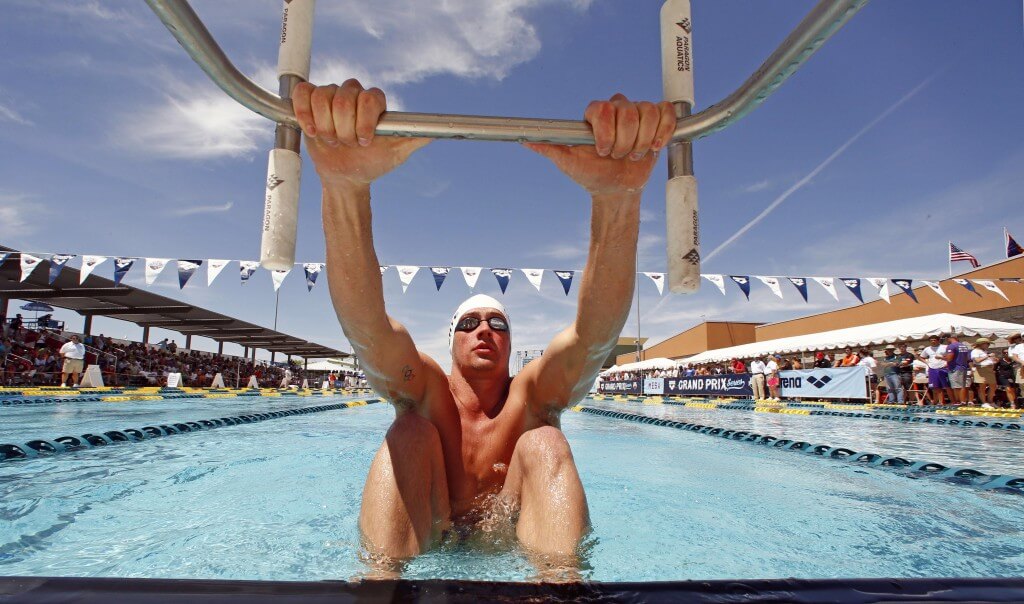Try Out This Aerobic Endurance Set

PHOENIX, Arizona, June 18. CONCORD College head coach Ronald Hehn is back with another weekly workout submission. This week, he’s designed a workout that is set to challenge a swimmer’s breath control, aerobic endurance and finishing speed.
Components of the Work-Out:
Warm-Up: The Warm-Up requires the athlete to maintain a consistent stroke count (i.e. number of strokes) per length while maintaining consistent Kick-Outs. The athlete will be challenged to be disciplined despite the tendency for the underwater segment of the length to shorten due to fatigue; in that case, the athlete would have a longer distance to swim and might increase stroke count because of the increased distance to cover rather than the reduced distance per stroke. Establish an honest stroke count on the 25; then, maintain a consistent stroke count throughout the 50 and 75. Perform the first two rounds freestyle; the second two rounds may be the athlete’s choice.
Warm-Up Set: The Warm-Up Set is designed to incorporate both Intermittent (i.e. Breathe every 3/5/7/9 strokes per length) and Prolonged Hypoxia (i.e. increasing required kicks underwater per length).
The set simulates a “broken” 500. The Intermittent Hypoxic swim segment (i.e. 1×200) slightly elevates the athlete’s heart rate. The Threshold segment (i.e. 3×50) is designed to further increase the athlete’s heart rate, while challenging the technique despite fatigue. On the Prolonged Hypoxic kick segment (i.e. 100), the athlete must focus on using the legs to establish a high body position; the legs prevent the body from sinking (i.e. lowering in the water) when fatigued. It is practical to increase underwater kicks because a fatiguing kick requires increasingly more kicks to achieve a consistent distance. The anaerobic exercise during the set yields an increase in blood-lactate levels. On the final 50, the athlete may utilize built-up Lactate to generate energy via the Cori Cycle while maintaining proper technique for a BEST Effort finish.
Main Set: The Main Set is designed to challenge the Breath Control, Aerobic Endurance, and Finishing Speed of the athlete. The athlete must focus on using the most efficient technique during the Breath Control and Aerobic segment. The body should be prepared from the Warm-Up Set to complete these segments with ease. During the Threshold segment (i.e. 2×75) the athlete must elevate the heart rate while maintaining proper technique in order to effectively execute the final two 100’s. The final 2×100’s should add up to be approximately the athlete’s goal 200 time in-season. The gradually increasing anaerobic demand elevates the athlete’s blood-lactate levels and decreases body pH.
Warm-Down Set: The Warm-Down set is designed to gradually lower the athlete’s heart rate following a short duration increased heart rate. Metaphorically it could be considered “revving the athlete’s engine”. The 25 Kick should be done in a streamline, on the front (i.e. prone), with a flutter kick; the athlete must attempt to maintain proper body line and minimize the arch in the back. This is a very difficult activity; the coach should expect frustration from the athletes. Lactate is a great energy source; it can fuel the athlete throughout the Warm-Down Set using Lactate generated during the Warm-Up Set and Main-Set.
Terms:
Lactic Acid: Substance created in muscles when energy (i.e. glucose) is generated without oxygen.
Lactate: A by-product of lactic acid found in the blood stream resulting from lactic acid losing a hydrogen ion due to a decreased body pH (i.e. more acidic).
Cori Cycle (Part 2): The metabolic pathway that converts Lactate to fuel, glucose, which is later stored in the muscles until there is a demand for movement. Lactate in the blood is converted to glucose when blood passes through the liver, a process called gluconeogenesis. In my experience, the process takes approximately 30 minutes.
Ronald Hehn is entering his second year as head coach at Concordia, and is the founder of the DakotaSota Swim Club in Fargo. Hehn had an impressive collegiate career as a All-American at Indiana University, and also swam at both the 2008 and 2012 U.S. Olympic Trials. To see more from Hehn, check out his swimming workouts Facebook page.



